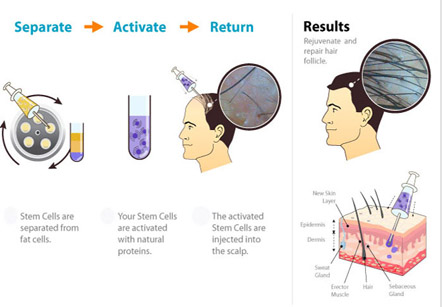Baldness
Introduction
Stem cells are considered as the building blocks of life. These cells have the remarkable potential for regeneration and development into various different cell types in the body during early life and growth.
Stem cell therapy involves the use of stem cells for regeneration of the diseased and damaged tissues or organs to improve the quality of life of people suffering from various incurable diseases.
Newer and advanced regenerative medicines can use stem cells to create living and functional tissues. This can help to regenerate and repair tissue and organs in the body which are damaged due to age, disease and congenital defects. Stem cells have the power to migrate selectively to these damaged areas and develop into new cells and tissues by performing a repair and a renewal process. This can possibly result in anatomical as well as functional restoration. Regenerative medicine has the potential to provide a cure for failing or impaired tissues.
Iranian scientists have moved to the forefront in embryonic stem cell research, according to a recent joint study by Harvard University and the Massachusetts Institute of Technology

Regenerative medicine is an emerging branch of medicine with the goal of restoring organ or tissue function for patients with serious injuries or chronic disease. In these cases, the body’s own responses are not sufficient enough to restore functional tissue. A growing crisis in organ transplantation and an aging population due to advances in medical field have driven a search for new and alternative therapies. There are thousands of patients who are in the transplant-waiting list in each major hospital. In addition there is a wide range of major unmet medical needs which might be addressed by regenerative technologies.
While some researchers believe that the therapeutic potential of stem cells has been overstated, an analysis of the potential benefits of stem cells based therapies indicates that millions of people may be benefitted with this therapy, especially the patients with cardiovascular disorders, autoimmune disorders and diabetes. Patients with other disorders likely to benefit include osteoporosis, severe burns, and spinal cord injuries.
Treatment of baldness with stem cell therapy
Normal hair follicles also contain stem cells, and some researchers postulate that the research on these follicle stem cells may lead to success in treating baldness through activation of the stem cells progenitor cells. This treatment is thought to work by activating already existing stem cells on the scalp. Later treatments may be able to signal the follicle stem cells to give off chemical signals to nearby follicle cells which have shrunk during the aging process. These aged follicles in turn respond to these signals by regenerating and making healthy hair. Most recently, scientists have claimed that stem-cell therapy may lead to a significant and visible improvement in follicular hair growth. Results from such experiments are yet to be confirmed.
Stem cells have the unique characteristic of plasticity; which means the ability to give rise to all of the different tissues of the human body. They can differentiate into many cell types with specific functions.
Stem cells have got the ability to divide indefinitely and regenerate various important structures in embryonic life. This ability is utilized for extensive research on the stem cells in various ways.
Stem cells have the unique characteristic of plasticity; which means the ability to give rise to all of the different tissues of the human body.
The hair follicle contains stem cells in the centre of the follicle and these cells ensure a continuous supply of cells for the fast multiplying hair cells. These cells have hormonal receptors on them and respond to changes in the hormone levels. These stem cells are progressively lost as the baldness progresses and this may result in the male and female pattern baldness.
Research has shown very promising results with the stem cell therapy for hair loss by replenishing the lost stem cells. These stem cells are pure human stem cells produced in lab by genetic engineering technology. These stem cells are harvested and then multiplied in the laboratory to produce the required quantity of stem cells for the treatment purpose.
The treatment with the stem cells requires multiple sessions. The method of injection into the scalp is by using specific instruments especially designed for fine and precise drug delivery into the hair follicle. Another method of introducing the stem cells into the scalp is by the scalp rolling technology where the stem cells are introduced by means of tiny punctures made in the scalp surface.
Even advanced grades of hair loss have shown reasonably good results with this therapy. The protocol of therapy is to introduce stem cells once in every 15 days. It is absolutely safe and without any known side effects except for a mild pain felt during the injection in the scalp.